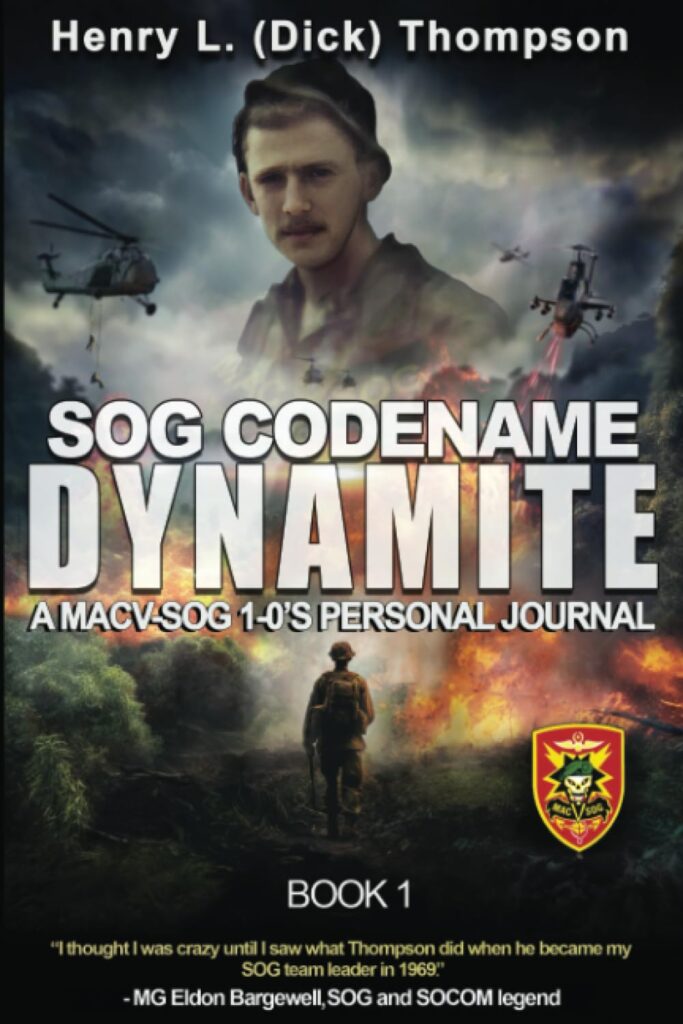By Henry L Thompson, Ph.D..
Independently Published, 2023.
ISBN 979-8-3994-2435-4. Photographs. Pp. 218. $19.99.
Pp. xiv, 266. $19.99.
Dr. Henry L. Thompson (Lieutenant Colonel, USA-Ret.) witnessed and participated in some of the most covert combat operations the U.S. Army undertook during the Vietnam War. These were performed by a unit that considered everybody they encountered as the enemy in the missions they undertook, sure in the knowledge they were all alone in hostile territory. The North Vietnamese military celebrated any time they killed a member of it, and the unit endured a 200 percent casualty rate. “You have volunteered to serve in the Military Advisory Command Vietnam, Studies and Observation Group (MACV-SOG)…You have just become a member of the most elite fighting force in the world…We are North Vietnam’s worst nightmare!” (p. 43). SOG Codename Dynamite is Thompson’s action-packed personal memoir of his days as a 1-0 (‘one-zero’) team leader in SOG operations. The memoir is split into two volumes, with this review focusing on the first book.
The subtitle of A MACV-SOG 1-0’s Personal Journal is a perfect description of the book. Thompson did not set out to write historical data or the history of MACV-SOG; Codename Dynamite is purely a memoir. While more detail on MACV-SOG’s past and role in the context of the war would have been appreciated, this book primarily portrays what Thompson saw and knew at that time, with only some additional hindsight notes. The sheer amount of detail put into examining each mission makes it a must-read for those interested in the nitty-gritty of SOG operations in the Vietnam War. Thompson depicts more than the impressive battles. He sheds light on every aspect of MACV-SOG’s work, even the indigenous rations he ate. Thompson tackles mission preparation with an appreciative military precision, at times almost reading like more personable, less detached after action reports. When depicting combat action, however, the narrative does not shy away from the mud and the blood in lurid detail (especially the opening four paragraphs, which portray life and death at point blank range).
Volume One begins with Thompson’s childhood, goes into training starting in January 1967, and then focuses on nine missions within and then leading MACV-SOG Recon Teams. Starting in RT (Recon Team) Alabama, Thompson’s first mission began in early December 1968. All four of his missions with RT Alabama were in quick succession, and in less than a month he was team leader for RT Michigan. The book ends in the middle of his fifth mission with RT Michigan at the end of February 1969. In the three-month period focused on in this book, Thompson witnessed and participated in more combat action than the average Army company in a year, and it ends while he’s still “in country.”
At the start of his combat tour, Thompson depicts each mission’s full cycle including post-mission training, the latter often in the form of a tabular summary. The cycle goes warning order, mission briefing, prep, insertion, execution, extraction, debriefing, and repeat (p. 162). Objectives depicted in the book include wire taps, search and destroy, sabotage, interdiction, prisoner snatch, and perimeter security. Once readers know the drill and can infer that all of these things were happening in each mission, detail is appreciably reduced, instead hitting the highlights. Throughout the book every mission’s sub-chapter ends with “lessons learned,” personal takeaways that Thompson absorbed. Each lesson is delivered in bullet point format, summarizing the key takeaways from the mission described previously. Interspersed are tables for equipment and training; descriptions of the kind of support each unit had; the roster of every team; and more. Images are healthily dispersed throughout the book, not always of great quality, but all with good captioning and appropriate positioning to the text.
The independent publishing of this memoir should not deter a reader. In comparison to memoirs from established presses, the only indication of lacking a professional publisher is the relatively low quality of many images. There are few typos. There is a glossary for many of the acronyms, equipment, and jargon used. Thompson writes with a recognizable memoir style. While there are sections that occasionally go on more than necessary, Volume One of SOG Codename Dynamite in no way overstays its welcome. Rather, it leaves the reader wanting and looking forward to Volume Two.
Josh Cline
Rockville, Maryland
